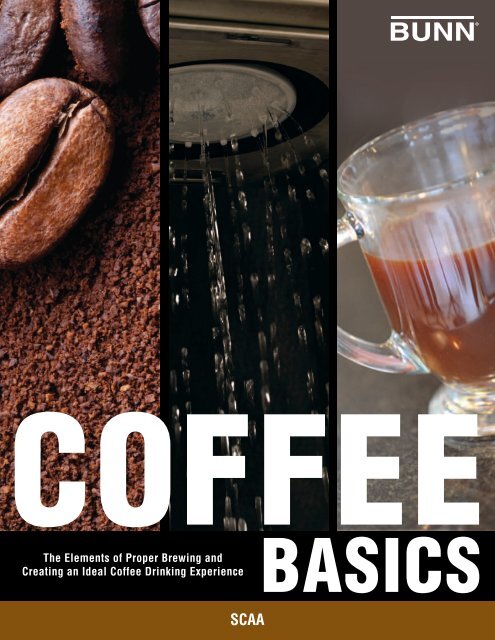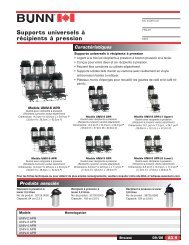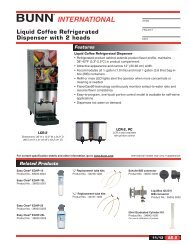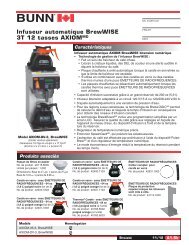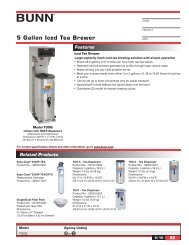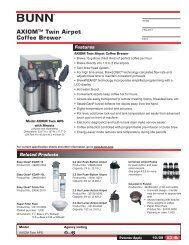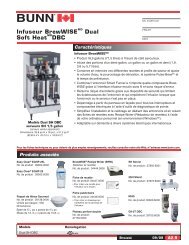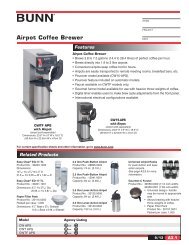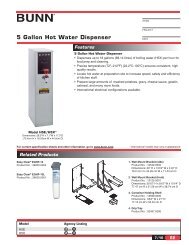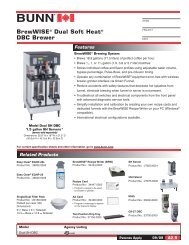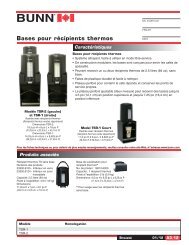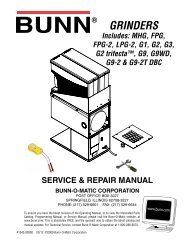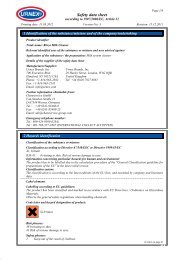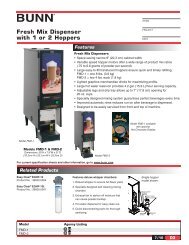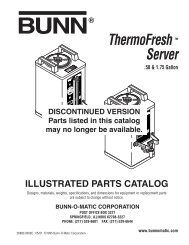Coffee Basics SCAA - Bunn
Coffee Basics SCAA - Bunn
Coffee Basics SCAA - Bunn
Create successful ePaper yourself
Turn your PDF publications into a flip-book with our unique Google optimized e-Paper software.
COFFEE<br />
BASICS<br />
The Elements of Proper Brewing and<br />
Creating an Ideal <strong>Coffee</strong> Drinking Experience<br />
<strong>SCAA</strong>
WATER<br />
THE ELEMENTS OF Proper BREWING<br />
Fresh, good-tasting water is essential since it makes up more than 98 percent of a cup<br />
of coffee.<br />
Mineral content can affect taste. For best results, water should never be artificially<br />
softened and should not exceed the following parts per million (ppm) of dissolved<br />
minerals:<br />
• Ideal – 50-100 ppm (50-100 mg/L) or 3 to 6 grains of hardness<br />
• Acceptable – Below 300 ppm (300 mg/L) or 18 grains of hardness<br />
BUNN offers a complete line of commercial-grade water quality filtration systems for use with BUNN<br />
commercial brewing equipment to ensure customers are getting the best tasting beverage possible.<br />
TIME<br />
The brewing time, or the<br />
time water is in contact with<br />
coffee grind, determines the<br />
amount of coffee material<br />
extracted. This is the major<br />
component affecting flavor.<br />
Contact/brew time should never exceed 8 minutes.<br />
TEMPERATURE<br />
The temperature of the water during brewing<br />
affects flavor and extraction.<br />
• Ideal Water Temperature – 195º - 205ºF<br />
Higher temperatures may result in undesirable<br />
coffee flavor and lower temperatures will result<br />
in poor extraction.<br />
TURBULENCE<br />
Turbulence is created as<br />
the water passes through<br />
and over the coffee. It<br />
should cause the particles<br />
to separate and create a<br />
uniform flow of water around<br />
them for proper extraction.<br />
FILTRATION<br />
Paper filters produce the clearest<br />
cup of coffee. BUNN filters are:<br />
• Porous enough to allow free flow of the<br />
extracted coffee solubles.<br />
• Perfect for coffees requiring exact brewing,<br />
like decaf and flavored coffees.<br />
• Strong enough to prevent collapsing.<br />
The paper stock used in manufacturing<br />
BUNN filters is produced using an elemental<br />
chlorine-free method.<br />
CLEANLINESS<br />
Make sure everything related to coffee brewing and serving is clean and free from lime<br />
and hard water deposits. Specifically, assure the following are spotlessly clean:<br />
• Serving area • Sprayhead/Funnel • Servers • Water Reservoir/Pitcher<br />
Never clean with a steel wool or other abrasives which can cause flaking or scratching which can<br />
lead to further pitting, corrosion and deposits.
THE SCIENCE OF THE BREWING PROCESS<br />
Wetting<br />
The grounds begin to absorb the hot water from the sprayhead and release gasses from the coffee. For<br />
consistent extraction from all parts of the coffee grounds, the entire bed of coffee must be evenly wet in the<br />
first 10% of the brew cycle time.<br />
Extraction<br />
The water-soluble materials<br />
dissolve and move out of the coffee<br />
grounds and into the water. The<br />
best flavors are extracted at the<br />
beginning of the process as seen in<br />
the Brew Cycle Time table.<br />
High Solids<br />
(Best flavor and<br />
least bitterness)<br />
Average Solubles<br />
(Least acids)<br />
Low Solids / Low pH<br />
(Most bitterness<br />
and astringency)<br />
Hydrolysis<br />
Through this chemical reaction, the<br />
materials created during extraction<br />
break down further into water<br />
soluble proteins and sugars.<br />
TASTE<br />
BREW CYCLE TIME<br />
1 st Phase 2 nd Phase 3 rd Phase<br />
MATCH THE GRIND TO BREW TIME<br />
The brewing or water contact time with the coffee grounds is primarily determined by the grind size and bed<br />
depth. A longer brew time is required for the water to penetrate the larger grind particles. The recommended<br />
brewing contact times for each grind size are shown here.<br />
1<br />
2 3 4 5 6 7 8<br />
General Guidline: The finer the grind, the shorter the time.<br />
Brewer Cycle Timing<br />
The brew cycle delivery time of a coffee brewer<br />
assists in determining the recommended coffee<br />
grind to produce a quality cup. Experimenting with a<br />
coarser or finer grind will help operators discover the<br />
preferred coffee flavor profile.<br />
Bed Depth<br />
The ideal depth of the coffee bed in the brew basket<br />
is 1-2 inches regardless of the volume of brew. If a<br />
coffee bed is less than 1 inch, the water may move<br />
through it too quickly and under-extract. Water moving<br />
too slowly through a bed depth of more than 2 inches<br />
may cause over-extraction and a bitter taste.
THE TECHNIQUE OF BREWING CONTROL<br />
COFFEE BREWING CONTROL CHART<br />
According to this chart developed through years of research and testing and now used by the Specialty<br />
<strong>Coffee</strong> Association of America, every great cup of coffee has three important variables—strength, extraction<br />
and brewing ratio. By plotting the relationship between these factors, it is possible to produce the ideal<br />
coffee flavor and drinking experience.<br />
Brewing Ratio | Ounces of Ground <strong>Coffee</strong> per Half-gallon<br />
Brewing Ratio<br />
The red diagonal lines represent brewing<br />
ratios of ground coffee used per halfgallon<br />
of water. The ground coffee<br />
measurements are displayed in ounces<br />
across the top and down the right side of<br />
the Chart.<br />
Strength (Solubles Concentration)<br />
The left side of the Chart indicates<br />
strength as a percentage. Other Control<br />
Charts may include total dissolved solids<br />
(TDS). The ideal percentage of coffee<br />
flavoring material in the finished cup is<br />
1.15% to 1.35%, and is most accurately<br />
measured by a Brew Strength Meter,<br />
hydrometer or refractometer.<br />
Extraction (Solubles Yield)<br />
Approximately one-fourth to one-third<br />
of a roasted coffee bean is matter that<br />
will readily dissolve in water during the<br />
brewing process. The other portion<br />
is bean fiber that isn’t soluble during<br />
normal brewing. The bottom of the Chart<br />
converts the fraction of the original dry<br />
ground coffee that has ended up in the<br />
finished cup to a percentage. The ideal<br />
range is 18% to 22% of the solubles.<br />
Grind size and brew time play a critical<br />
part in extraction.<br />
Optimum Balance<br />
Balancing strength and extraction<br />
produces a standard designated as<br />
“Golden Cup” by the Specialty <strong>Coffee</strong><br />
Association of America.<br />
USING THE CHART<br />
By using the weight of ground coffee in<br />
the brew basket, the volume of water<br />
used, and the strength of the brewed<br />
coffee, you can plot these to determine<br />
the extraction. The objective is to get<br />
to the Optimum Balance area. If you<br />
use 4 oz. of coffee and the strength of<br />
the brew was determined to be 1.40%,<br />
follow the red line labeled 4.00 oz down<br />
the red diagonal to the 1.40% grid line,<br />
and then straight down vertically to the<br />
bottom of the chart to extraction which is<br />
approximately 20.5%. Even though the<br />
extraction falls within the ideal range, this<br />
coffee is STRONG. To move the outcome,<br />
extraction needs to decrease to 18% -<br />
19.8% by decreasing the brew time and/<br />
or increasing the grind size.
unn technology gives you control<br />
Solids in the Brew<br />
During the brew process the watersoluble<br />
materials (solids) dissolve<br />
and move out of the coffee grounds<br />
and into the water. The level of<br />
solids changes while brewing,<br />
effecting the flavor, color, body and<br />
aroma of the coffee.<br />
Brew Time<br />
1 st<br />
Phase<br />
2 nd<br />
Phase<br />
3 rd<br />
Phase<br />
High Solids<br />
(Best flavor and least bitterness)<br />
Average Solubles<br />
(Least acids)<br />
Low Solids / Low pH<br />
(Most bitterness and astringency)<br />
This is why coffee should never<br />
be served before the brewing<br />
process is completed! All three<br />
phases combine to produce the<br />
ideal flavor.<br />
We manage the science of brewing so you don’t have to. BUNN offers a line of<br />
precision brewing and serving systems that are designed to produce optimum flavor.<br />
The machine matters!<br />
Equipment featuring Digital Brewer Control<br />
gives the operator control of the brewing process<br />
to create a variety of coffee recipes from a single<br />
origin of bean, or perfect recipes for different blends<br />
of beans.<br />
Pre-infusion: Control over the wetting process<br />
The sprayhead dispenses hot water and then turns<br />
off, allowing the wetting phase to complete.<br />
Pre-infusion ensures that the coffee will be ready<br />
for the extraction phase when the sprayhead turns<br />
back on.<br />
Pulse brew: Control over the extraction phase<br />
The sprayhead dispenses hot water then goes<br />
through a cycle of turning off and back on. Pulse<br />
brew enables you to adjust the flavor of your coffee<br />
by extending brew times.<br />
Brewed coffee should be enjoyed while flavor and aroma are at their peak. BUNN offers<br />
a range of holding and serving equipment designed to keep your coffee at its best.<br />
Ideal holding temperature: 175ºF to 185ºF<br />
Most volatile aromatics in coffee have boiling points<br />
well below that of water and continue to evaporate<br />
from the surface until pressure in the serving<br />
container reaches equilibrium. A closed container<br />
can slow the process of evaporation.<br />
Ideal serving temperature: 155ºF to 175ºF<br />
Volatile aromatics in coffee are not perceived when<br />
coffee is served at lower temperatures.<br />
Ideal holding time: 20 minutes in an open top<br />
decanter / 60 minutes in a closed container<br />
Holding coffee longer will result in loss of the<br />
smooth, sweet and complex flavors and instead<br />
produce a scorched or bitter taste.<br />
Variable Bypass: Control over brew strength<br />
Bypassing a percentage of the water around the<br />
ground coffee allows you to create unique flavors.<br />
Digital Temperature: Control over brew temperature<br />
With Digital Brewer Control, you have the option to<br />
set the brewing temperature precisely where you<br />
want it. The low temperature brew lock-out feature<br />
ensures adequate water temperature.<br />
Extraction Systems: Control over water distribution<br />
From traditional BUNN sprayhead designs to the<br />
BUNN 21-hole sprayhead, you can choose the<br />
spray pattern that yields the ideal flavor for your<br />
taste profile.<br />
See other BUNN programming features<br />
on the back panel<br />
holding and serving know how<br />
E9000.0008C<br />
10/11 ©2011 <strong>Bunn</strong>-O-Matic Corporation
<strong>Coffee</strong> terms<br />
The process of running hot water through coffee removes various materials from the grind. Those<br />
materials are:<br />
Soluble Materials: Compounds that dissolve in water.<br />
Non-soluble Materials: Compounds that do not dissolve in water.<br />
Volatiles: Soluble materials that evaporate easily.<br />
Non-volatiles: Soluble materials that do not evaporate, but stay in solution.<br />
The terms used to describe the characteristics of the coffee drinking experience are:<br />
Fragrance: Sometimes confused with aroma, this is the smell of ground coffee before the addition of water.<br />
Aroma: The gases that evaporate as ground coffee is exposed to water.<br />
Flavor: The liquids that are responsible for the overall taste of coffee.<br />
Acidity: The taste of coffee that creates differing sensations on certain areas of the tongue.<br />
Body: The solids that determine the way coffee feels in your mouth.<br />
Aftertaste (or Finish): The lingering remnant of taste after the coffee is swallowed that often changes over time.<br />
BUNN Programming FEatures<br />
BrewLOGIC ® Easy programming compensates for flow rate variations to ensure consistent dispense levels when<br />
water quality is a consideration.<br />
BrewWISE ® , Smart Funnel ® and Smart Hopper ® Features RFID communications between grinder, funnel, and<br />
brewer, managing the brewing process from start to finish consistently and without error.<br />
BrewWISE ® Recipe Writer Unique information storage and transfer media dramatically reduces brewer programming<br />
times and input errors.<br />
BrewMETER ® Simplifies pulse brew and allows extraction manipulation with the touch of a button.<br />
BrewWIZARD ® Easy access to the most used setup parameters, including a lock-out feature to prevent brewing if the<br />
water is less than ready temperature<br />
SmartWAVE ® A BUNN exclusive design that uses technology to increase turbulence in the brew funnel, providing<br />
more contact time between water and coffee and uniformity of extraction.<br />
Others include: Language/Units, Temperature, Freshness Timer, Advertising, Sanitation Timer, Recipe Cards,<br />
Service & Asset Numbers, and Brew Counters<br />
RESPECT<br />
BUNN is committed to environmental stewardship and continually strives to incorporate<br />
a respect for natural resources into our daily business practices and products. This<br />
brochure is printed on paper using 30% post-consumer waste.<br />
EARTH<br />
®<br />
1400 Stevenson Drive, Springfield, IL 62703 USA<br />
800-637-8606 | 217-529-6601 | www.BUNN.com


